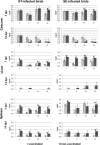Efficacy of a Salmonella live vaccine for turkeys in different age groups and antibody response of vaccinated and non-vaccinated turkeys
- PMID: 29970192
- PMCID: PMC6029038
- DOI: 10.1186/s13104-018-3524-1
Efficacy of a Salmonella live vaccine for turkeys in different age groups and antibody response of vaccinated and non-vaccinated turkeys
Abstract
Objective: Human Salmonellosis continues to be one of the most important foodborne zoonoses worldwide, although a decrease in case numbers has been noted in recent years. It is a foodborne zoonotic infection most commonly associated with the consumption of raw egg products but also with meat consumption including the consumption of poultry products. Turkey flocks in Europe have been reported to be affected by Salmonella infection, too. The present study examines the efficacy of a newly licensed Salmonella life vaccine in reducing infections with the Salmonella serovars Typhimurium and Enteritidis in turkeys. Turkeys were vaccinated the first day of life and at the age of 6 and 16 weeks. Groups of birds which had received different numbers of vaccinations were then submitted to challenge trials with either SE or ST.
Results: In vaccinated birds Salmonella counts in liver and spleen and, less effectively, in caecum were reduced compared to unvaccinated birds. In several groups serum antibody-titers were statistically significantly higher in vaccinated turkeys than in non-vaccinated ones at day seven post infection, but only in one out of six groups at day 14 post infection.
Keywords: Antibody response; Immunization; Salmonella; Turkey.
Figures


Similar articles
-
Immune response to Salmonella infections in vaccinated and non-vaccinated turkeys.Res Vet Sci. 2017 Dec;115:165-173. doi: 10.1016/j.rvsc.2017.04.002. Epub 2017 Apr 6. Res Vet Sci. 2017. PMID: 28437624
-
Immune response of turkey poults exposed at 1 day of age to either attenuated or wild Salmonella strains.Vet Immunol Immunopathol. 2016 Jun;174:1-10. doi: 10.1016/j.vetimm.2016.04.004. Epub 2016 Apr 5. Vet Immunol Immunopathol. 2016. PMID: 27185257
-
Antibody titers in turkeys increase after multiple booster vaccinations with an attenuated Salmonella live vaccine.BMC Res Notes. 2018 Jun 8;11(1):367. doi: 10.1186/s13104-018-3462-y. BMC Res Notes. 2018. PMID: 29884218 Free PMC article.
-
Estimation of the impact of vaccination on faecal shedding and organ and egg contamination for Salmonella Enteritidis, Salmonella Typhiumurium and monophasic Salmonella Typhimurium.Avian Pathol. 2014;43(2):155-63. doi: 10.1080/03079457.2014.896990. Epub 2014 Mar 24. Avian Pathol. 2014. PMID: 24617816
-
Safety of foods of animal origin: model for elimination of Salmonella contamination of turkey meat.J Am Vet Med Assoc. 1991 Oct 1;199(7):875-80. J Am Vet Med Assoc. 1991. PMID: 1769874 Review. No abstract available.
References
-
- Hafez HM, Jodas S. Salmonella Infections in Turkeys. In: Wray C, Wray A, editors. Salmonella in domestic animals. New York: CABI Publishing; 2000.
-
- Gast RK. Salmonella Infections. In: Saif YM, editor. Diseases of poultry. 1. Ames: Iowa State University Press; 2003. pp. 567–568.
-
- European Food Safety Authority Report of the task force on zoonoses data collection on the analysis of the baseline survey on the prevalence of Salmonella in turkey flocks, Part B. EFSA J. 2008;198:1–124.
-
- Bundesinstitut für Risikobewertung. Grundlagenstudie zur Erhebung der Prävalenz von Salmonellen in Truthühnerbeständen. 2008. http://www.bfr.bund.de/cm/208/grundlagenstudie_zur_erhebung_der_praevale.... Accessed 16 Feb 2018.
-
- Immerseel FV, Methner U, Rychlik I, Nagy B, Velge P, Martin G, et al. Vaccination and early protection against non-host-specific Salmonella serotypes in poultry: exploitation of innate immunity and microbial activity. Epidemiol Infect. 2005;133:959–978. doi: 10.1017/S0950268805004711. - DOI - PMC - PubMed
MeSH terms
Substances
LinkOut - more resources
Full Text Sources
Other Literature Sources

